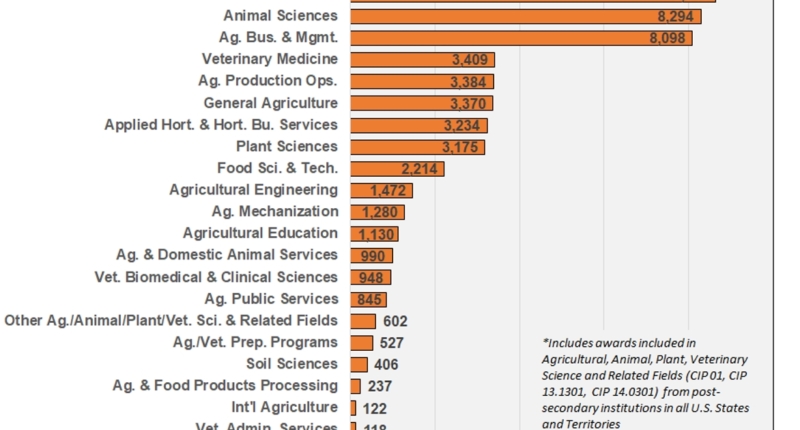The content provided includes information on the challenges faced by the agricultural industry in filling job positions for both in-demand occupations and those unique to food and agriculture. The article notes the need for different strategies to fill these positions and highlights the importance of engaging students early on in their careers to prepare them for specialized occupations. Data on completions by field of study are organized by Classification of Instructional Programs (CIP) codes and show where student interest lies in terms of program areas and how that interest has changed over time. The article also includes a brief on the characteristics of students completing agricultural-related degrees and certifications and how those demographic characteristics vary by program area. Finally, a list of relevant sources is provided for readers who want to further explore the topic.
The agricultural sector faces a persistent challenge in addressing its workforce needs. Slow migration and declining immigration within the U.S. agricultural workforce have limited the supply of farm laborers. To cope with tight labor markets and rising wages, many agricultural producers have adopted labor-saving technologies, which require new knowledge, skills, and abilities within their workforce.

Agricultural-related occupations require a mix of education, training, and experience, and the workforce needs of agricultural producers, suppliers, and service providers will continue shifting with the adoption of more automated technologies and knowledge-intensive activities. Therefore, U.S. post-secondary institutions must play a crucial role in training and educating the agricultural workforce to maximize the benefits of these technologies.
To better understand trends in agricultural-related degree and certification completions, the U.S. Department of Education’s National Center for Education Statistics’ Integrated Post-secondary Education Data System (IPEDS) provides program completer data. The data reveal the scale of completions over time and by state, as well as the program areas that attract the greatest student interest.
Animal and business-related programs produce the most agricultural-related degrees and certifications. However, there have been declines in award completions in areas such as agriculture production and management, plant sciences, and agricultural economics. In contrast, the number of awards in animal sciences and business and management programs have increased over the years.
Overall, the data highlights the changes in the number of potential new workers entering the agricultural workforce and the areas of student interest in agricultural-related programs. The agricultural sector must continue to address its workforce needs and adapt to the changing landscape of technology and knowledge-intensive activities to remain competitive. U.S. post-secondary institutions can play a key role in preparing the future agricultural workforce to meet these challenges.
Between July 2020 and June 2021, US post-secondary institutions awarded around 52,500 degrees and certifications in agricultural-related fields. Veterinary/animal health technologies, animal sciences, and agricultural business and management were the top program areas that accounted for almost half of all awards. However, programs such as veterinary medicine, agricultural production operations, general agriculture, applied horticulture, and plant sciences also contributed a significant number of awards.
The nation’s 123 land-grant institutions were the leading source of agricultural-related degrees and certifications, accounting for 45.8% of all awards. Meanwhile, two-year institutions contributed 30.0% of these awards, highlighting their important role in this field.
While agricultural-related degrees and certifications have grown by 46% since 2003, the growth rate was slower than the overall growth rate of post-secondary awards (57%) for most of the past two decades. The program area that experienced the largest growth during this period was veterinary/animal health technologies/technicians, followed by animal sciences and agricultural production operations.
Graduates from veterinary technician programs find work in practices focused on house pets, but many veterinary practices outside of more dense urban areas are mixed-animal practices that address the needs of both pets and large animals. On the other hand, agricultural production operations cover program areas such as crop production, animal livestock husbandry and production, aquaculture, and viticulture.
Overall, the data shows the changes in the number of awards in agricultural-related fields over time, the top program areas that attract the most student interest, and the leading sources of these awards. U.S. post-secondary institutions must continue to adapt to the evolving workforce needs of the agricultural sector and provide relevant education and training to prepare the future agricultural workforce to meet these challenges.
In recent years, U.S. post-secondary institutions have awarded fewer agricultural-related degrees and certifications compared to previous years. Applied horticulture and horticultural business services, agricultural business and management, and veterinary/animal health technologies/technicians are among the program areas that have experienced the greatest declines since 2019. Although the pandemic likely played a role in these declines, the smaller demographic of Generation Z may have had a greater influence, resulting in fewer traditionally aged post-secondary students.
California, Texas, and Florida accounted for almost one-fourth of all agricultural-related post-secondary awards in 2021. However, agricultural-related awards represent a greater relative share of total awards in smaller, agricultural states such as Wyoming, South Dakota, Iowa, Nebraska, and North Dakota. This is due to the agricultural sector’s significant role in these states’ less diverse economies. Among larger states, Texas, North Carolina, and Illinois had relatively greater concentrations of agricultural degrees and certifications.
Not all students completing agricultural-related degrees and certifications will find work in agriculture. Agricultural employers often hire workers with degrees and certifications from different fields. However, many graduates filling the unique roles in food and agriculture, such as agricultural equipment operators, large animal veterinarians, and food scientists.
Overall, the data shows recent trends and figures of agricultural-related degrees and certifications in the US, highlighting the program areas that have experienced declines and the states that produce the most awards. U.S. post-secondary institutions must continue to adapt to the evolving workforce needs of the agricultural sector and provide relevant education and training to prepare the future agricultural workforce to meet these challenges.
The agricultural sector’s workforce needs have been a long-standing challenge, with the slow migration within the U.S. agricultural workforce, combined with declining immigration, leading to a limited supply of farm laborers. Agricultural producers have increasingly adopted labor-saving technologies to mitigate the effects of tight labor markets and rising wages. However, effective adoption and implementation of these technologies require farm operators to develop new knowledge, skills, and abilities within their workforce.
The first brief in a series exploring trends in agricultural-related degrees and certification completions from U.S. post-secondary institutions focuses on the scale of completions over time, by state, and program area. According to the data from the U.S. Department of Education’s National Center for Education Statistics’ Integrated Post-secondary Education Data System, nearly half of all awards came from three program areas: veterinary/animal health technologies, animal sciences (including animal health and nutrition, dairy science, and livestock management), and agricultural business and management. The largest source of agricultural-related degrees and certifications were the nation’s 123 land-grant institutions, followed by two-year institutions.
Since 2019, U.S. post-secondary institutions have awarded fewer agricultural-related degrees and certifications than in previous years, with declines in program areas such as applied horticulture and horticultural business services, agricultural business and management, and veterinary/animal health technologies/technicians. This decline may be influenced by the new demographic reality resulting from Generation Z being smaller than the millennial generation.
While larger states produce the most agricultural-related awards, agricultural-related awards represent a greater relative share of total awards in states with less diverse economies where the agricultural sector plays a particularly important role. Therefore, it is necessary to connect with traditional educational partners like land-grant institutions and other important post-secondary institutions like community and technical colleges to address the workforce needs of the agricultural sector.
Filling the different types of occupations in the agricultural sector requires different strategies. While recruiting information technology workers to work in agricultural enterprises can pose a challenge, filling occupations unique to food and agriculture requires longer-term career pathway strategies, which involves engaging students early through career exploration opportunities and then connecting them to specialized training and education to prepare them for these more specialized occupations.
This data can help inform efforts intended to address the agricultural sector’s workforce needs, and the next brief in this series will examine the demographic characteristics of the students completing agricultural-related degrees and certifications and how those characteristics vary by program area.
The U.S. Department of Education has provided data showing the distribution of completions in agricultural-related fields, which can inform efforts to address the workforce needs of the sector. Data from July 1, 2020, to June 30, 2021, showed that post-secondary institutions in the U.S. awarded approximately 52,500 degrees and certifications in agricultural-related fields. The top three program areas where awards were granted were veterinary/animal health technologies, animal sciences, and agricultural business and management. These three areas alone contributed to almost half of all the awards granted. Larger states such as California, Texas, and Florida produced the most awards, while smaller, more agricultural states like Wyoming, South Dakota, Iowa, Nebraska, and North Dakota had a greater relative share of agricultural-related awards. Two-year institutions also played an important role in awarding 30.0% of the agricultural-related awards.
Since 2019, however, there has been a decline in the number of agricultural-related degrees and certifications awarded. Program areas that experienced the greatest declines since 2019 were applied horticulture and horticultural business services, agricultural business and management, and veterinary/animal health technologies/technicians. This decline may have been influenced by the COVID-19 pandemic, but the new demographic reality resulting from the smaller Generation Z cohort compared to the millennial generation is also likely a factor.
The distinction between occupations unique to food and agriculture versus those in demand throughout the economy is important in addressing the sector’s workforce needs. While finding workers for more broadly sought occupations can be a challenge for agricultural employers, filling occupations that are more unique to food and agriculture requires longer-term career pathway strategies, which involves engaging students early through career exploration opportunities and then connecting them to specialized training and education.
Completer data in agricultural-related fields are organized by Classification of Instructional Programs (CIP) codes, which organize completions by field of study. It includes all the awards included within CIP 01, agricultural education (CIP 13.1301), and agricultural engineering (CIP 14.03).
It is important to note that the CIP classification system is periodically updated. Programs related to veterinary studies were moved out of Health Professions and Related Programs (CIP 51) and into Agricultural/Animal/Plant/Veterinary Science and Related Fields (CIP 01) in the 2020 CIP codes. The program data presented here is based on the 2020 CIP codes, and crosswalks between the 2000 to 2010 CIP codes and 2010 to 2020 CIP codes were used to ensure a consistent time series.
The next brief in this series will examine the demographic characteristics of the students completing agricultural-related degrees and certifications and how those characteristics vary by program area.
This text lists a few articles and reports related to agricultural workforce needs, including studies on the labor shortage, precision agriculture, and workforce needs assessments in different states. The sources cover a range of topics, including the knowledge, skills, and abilities required for precision agriculture jobs, the approaching labor shortage due to demographic changes, and the current state of the agricultural workforce in various regions of the United States. The links to these sources provide valuable information for anyone interested in learning more about the agricultural workforce and its needs.
Don’t miss interesting posts on Famousbio










